76 - 90 of 319 records
JM-143: Awkward mistake in the date

Description: This cartoon portrays President Taft writing a message to Congress. In 1912, President Taft ran for reelection, most notably campaigning against his predecessor, Theodore Roosevelt, in the Republican primary. President Taft would eventually win the Republican primary. After losing that election, Roosevelt ran for president after creating his own party, the Bull-Moose party. The campaigning between Roosevelt and Taft was rigorous, and they ultimately split the the Republican vote in the 1912 presidential election. (Summary created by Mary Delano, MU History Intern, Spring 2018)
Member of: McCutcheon Editorial Cartoons - ALL (Collection)
Resource Type: Still Image
JM-181: Long speeches by those pictured
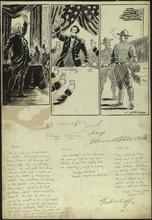
Description: This cartoon compares three speeches. The first speech on the left was Patrick Henry's famous speech, in which he stated "Give me liberty or give me death!". This speech was given on the eve of the Revolutionary War. The second speech was by Stephen Decatur, a commodore in the United States Navy. Decatur's speech was given at the conclusion of the War of 1812. The final speech was given by Private Sammy Jones during World War I. (Summary created by Mary Delano, MU History Intern, Spring 2018)
Member of: McCutcheon Editorial Cartoons - ALL (Collection)
Resource Type: Still Image
JM-168: Long distance driving
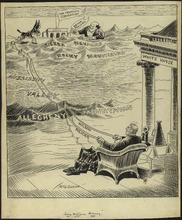
Description: Editorial cartoon depicting Wilson holding reins titled "Wilson policies" of a donkey heading toward the San Francisco Convention, where Bryan is placing a flag of his policies.
Member of: McCutcheon Editorial Cartoons - ALL (Collection)
Resource Type: Still Image
JM-144: Peace Talk
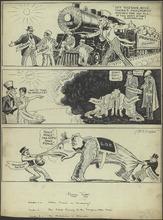
Description: In the first panel, capital and labor are in an argument. This is a personification of the series of labor disputes between workers and large business owners that were a common product of the Industrial Revolution. Usually these disputes were about implementing better employment practices such as better wages, workers' compensation, safety regulations, etc. This argument is delaying the train of 1916, which holds the economic prosperity the United States experienced due to it funding and manufacturing supplies for the European nations fighting in World War I. Uncle Sam, the United States, is attempting to resolve the conflict between Labor and Capital, so they can become ready to experience the prosperity 1916 is bringing. Notice the bottom notation says this "peace" is necessary. The second panel portrays a wide view of the world with the United States on the left and Europe on the right. On the left, Uncle Sam (the United States) is being asked by humanity to intervene and mediate in Europe. This exchange references those who thought the United States had a moral duty to help end World War I in Europe. On the right side of the panel, is a depiction of the World War I conflict being shielded from the glow of peace (the sun). The Allies (Britain, France, Italy) are fighting with the Teutons (Germany and its allies with Germanic roots). Looming over this fight are the personifications of financial and physical death. This shows the devastation World War I has caused in Europe. The last panel depicts the internal debate between politicians in the US about what action should be taken regarding European intervention. On the left, "progressive" politicians pull the elephant ( the Republican party) towards peace, meaning they want the US government to help European nations negotiate a peace. Notice the Progressive politician is dressed in relatively simple clothing, which suggests he appeals more the common man. The "old guard" politician is pulling the Republican party away from peace, meaning he wishes the United States to remain neutral and not intervene in World War I. He is dressed more upscale, which suggests his ideas represent the older, more wealthy population that is profiting on the war. (Summary created by Mary Delano, MU History Intern, Spring 2018)
Member of: McCutcheon Editorial Cartoons - ALL (Collection)
Resource Type: Still Image
JM-140: Proposed solution to the disputed problem
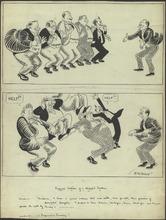
Description: This cartoon depicts the potential candidates for the Republican primary election of 1912. The first candidate portrayed on the left is President Taft, who was running for re-election. The second candidate is James Sherman's, President Taft's former vice president. The next candidate is a senator from Massachusetts, Boies Penrose. William Barnes, Jr., a politician and journalist from New York, is displayed as a potential runner. The last candidate depicted in the cartoon is Winthrop Crane, another senator from Massachusetts. All these men appear to be eager to run in the Republican primary in the top panel. However, some of these men are accused of being fraudulent candidates. This means they have been accused of not actually been favored by the public to run for the presidency To ensure their legitimacy, a man suggests a preferential primary. A preferential primary is an election that determines the nominee for the presidency through the preference of voters or through delegates (these delegates most vote for the winning primary candidate). The practice of a preferential primary contradicts against the tradition of political bosses attempting to organize the outcome of elections. The candidates of the elections all find this news distressing in the bottom panel. (Summary created by Mary Delano, MU History Intern, Spring 2018)
Member of: McCutcheon Editorial Cartoons - ALL (Collection)
Resource Type: Still Image
JM-139: For chairman of the convention
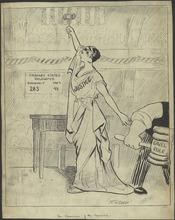
Description: This cartoon shows Lady Justice presiding over the Republican Convention for the 1912 primary election. Former president, Theodore Roosevelt, was running against president incumbent Taft. President Roosevelt seems to have more delegate votes than Taft, but Taft would ultimately be renominated for the presidency. Roosevelt claimed Taft stole delegates that should have been awarded to him, making him lose the election. After losing the Republican primary, Theodore Roosevelt began his own party, the Bull-Moose Party. Taft and Roosevelt would eventually split the Republican vote, which allowed Woodrow Wilson to be elected as president in 1912. (Summary created by Mary Delano, MU History Intern, Spring 2018)
Member of: McCutcheon Editorial Cartoons - ALL (Collection)
Resource Type: Still Image
JM-184: Peace talk

Description: The cartoon shows the interpreted process of peace talks during World War I. The top panel shows the German people being dragged to peace by the Kaiser Wilhelm II. The second panel shows the Reichstag calling for peace after the kaiser orders them to begin discussions. In 1917, the United States had entered World War I, and Germany's and the Axis powers' chance of victory was becoming smaller and smaller. This made them more willing to negotiate for peace than in previous years of the war. The third panel shows the American stock market falling in value. This drop in the stock market was caused by the peace talks. Supplying weapons and other resources in World War I significantly improved the economy of the United States. Many factories and other means of productions had been created solely to meet the needs of the global conflict. As World War I came to a close, the United States large profits from the war effort began to decline. (Summary created by Mary Delano, MU History Intern, Spring 2018)
Member of: McCutcheon Editorial Cartoons - ALL (Collection)
Resource Type: Still Image
JM-202: Cartoons of the day
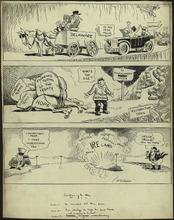
Description: Editorial cartoon depicting three separate cartoons. In the top panel, a man on a cart titled "Delaware" blocks women in cars titled "Suffrage" from passing him on the road to the 1920 polls. In the middle panel, "Germany" kills his pack horse ("Hope") underneath a burden of "Economic Terms of the Treaty"; he is unable to continue on "Reparation Trail". In the bottom panel, Uncle Sam and John Bull attempt to communicate via telephone, but uproar in Ireland blocks connection.
Member of: McCutcheon Editorial Cartoons - ALL (Collection)
Resource Type: Still Image
JM-090: Grosvenor and Platt present different views on McKinley

Description: Editorial cartoon depicting Charles Henry Grosvenor and Thomas C. Platt presented as sideshow hawkers speaking to a group of people. They each point to a large banner focusing on President William McKinley behind them. On Grosvenor's banner, McKinley is presented as the "largest man in the world." On Platt's banner, McKinley is presented as the "smallest man in the U.S."
Member of: McCutcheon Editorial Cartoons - ALL (Collection)
Resource Type: Still Image
JM-295: Sunken ships are historic trouble-breeders
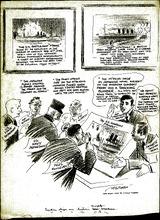
Description: Editorial cartoon depicting a group, including FDR, examine sinking of U.S. gunboat Panay.
Member of: McCutcheon Editorial Cartoons - ALL (Collection)
Resource Type: Still Image
JM-204: As Uncle Sam prepares to get back in the European game

Description: Editorial cartoon depicting Uncle Sam being warned to participate only in an advisory way by U.S. Congress as he climbs over a fence to join a European Reparation Committee.
Member of: McCutcheon Editorial Cartoons - ALL (Collection)
Resource Type: Still Image
JM-220: If there was referendum on war debt cancellation

Description: Editorial cartoon depicting the outcry against a referendum on the collection of war debts in the aftermath of WWI.
Member of: McCutcheon Editorial Cartoons - ALL (Collection)
Resource Type: Still Image
JM-206: Three scenes of hypocrisy
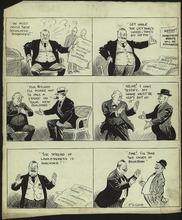
Description: Editorial cartoon depicting three panels, each panel with its own scene of hypocrisy. In the top panel, a man upset by socialists and unemployment then posts a notice for his apartment complex advancing the rent for his tenants to get their money while he can. In the middle panel, a man is being bribed but refuses to testify against the one bribing him. In the bottom panel, a man is shocked by the spread of lawlessness, but then he buys two cases of bourbon during a potential prohibition-era cartoon.
Member of: McCutcheon Editorial Cartoons - ALL (Collection)
Resource Type: Still Image
JM-268: Supposing American tourists in France tried to adopt the stalling on the payment plan
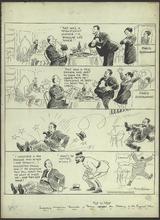
Description: Editorial cartoon depicting an American tourist finishing a large meal at a French restaurant. When he is handed the bill, he offers to pay for it on condition that another man who owes him money pays him back. The restaurant owner kicks the tourist out, and a policeman comes over and asks what happened.
Member of: McCutcheon Editorial Cartoons - ALL (Collection)
Resource Type: Still Image
JM-201: Making a bad situation worse
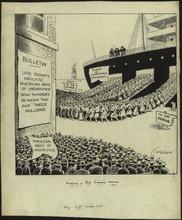
Description: Editorial cartoon depicting undesirable immigrants coming off a ship near Ellis Island while an army of the unemployed Americans watch them.
Member of: McCutcheon Editorial Cartoons - ALL (Collection)
Resource Type: Still Image
Pagination
- Previous page
- Page 6
- Next page